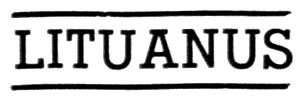
June, 1958 Vol. 4, No. 2
Managing Editor P. V. Vygantas
 |
www.lituanus.org |
| Copyright
© 1958 Lithuanian
Students Association, Inc. June, 1958 Vol. 4, No. 2 Managing Editor P. V. Vygantas |
|
Lithuanian and the Germanic Languages
Dr. ANTANAS KLIMAS
Dr.
ANTANAS KLIMAS, author of numerous articles, completed his graduate
studies at the University of Pennsylvania in Philadelphia, where he was
an instructor in German. Currently he is an assistant professor of
German at the University of Rochester, N. Y.
A. Introduction
It is common for a non-specialist in the field of linguistics to believe that Lithuanian might be somehow similar to Polish, Russian, Ukrainian, perhaps even to Estonian and Finnish (the latter two do not even belong to the Indo-European languages!), but very many people will express their belief that German, not to speak of English, has "nothing to do with Lithuanian," i.e., that these are two completely "different" languages. This belief, especially in the U.S.A., stems from the practical experience of an average American. In about the 3 last generations he has been watching immigrants from Poland and Russia, from Ukraine and Lithuania and from other European countries coming in, settling down and beginning to live in the new country. All these immigrants often lived side by side, they established their churches, schools and various organizations, a multitude of these, and the "on-looking" local American did not observe the differences in their languages which were "all the same" to him. The Americans knew something about German, French, Italian and Spanish because these languages were taught in some schools (Spanish was also spoken in New Mexico, Texas and California, some French in the northern New England states, etc...) Italian was better known as the language of operas, songs, etc. There were also numerically more immigrants from these nationalities. But the languages the average American "could not make out" were to him "one and the same thing."
Lithuanians themselves could not explain these differences between their own language and the others: like most of us, they knew their language well, but they did not know much about their language itself. To them, languages like German and English certainly sounded like completely different languages in comparison with their native Lithuanian. This was simple. Let us take a practical example: who would think that Lith. dantis, E. tooth and G. Zahn originally were the same word in Primitive Indo-European. Or take Lith þàsis (pr. zhaasis, "þ" as "s" in E. measure), E. goose and G. Gans; or Lith. gimti ("g" as in E. good) "to be born," E. corne, G. kommen!!
Even if there were some similarities, they were so few (at least that is how they sounded) that any relation between Lithuanian and German or English was not even considered. Take such a sentence:
Lith.
mano brolis turi penkias
dukteris
E. my brother has five
daughters
In these two sentences, only the middle word, the verb turi, E. has, is not derived from the same word, while the other four words are derived from the same Indo-European forms. But who, without some knowledge of historical linguistics, would think that, for example, Lith. penkias and E. five are derived from the same original word: I. E. *penkwe?1)
NOTE: The entire article is availabel as a PDF: Lithuanian and the Germanic Languages